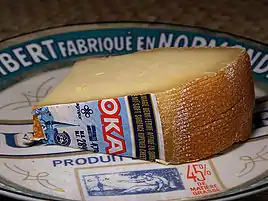Oka cheese
Oka is a semi-soft washed rind cheese that was originally manufactured by Trappist monks located in Oka, Quebec, Canada. The cheese is named after the town. It has a distinct flavour and aroma, and is still manufactured in Oka, although now by a commercial company. The recipe was sold in 1981 by Les Pères Trappistes to the Agropur cooperative.[1]
| Oka | |
|---|---|
 | |
| Country of origin | Canada |
| Region, town | The Laurentides, Oka |
| Source of milk | Cow |
| Pasteurised | Sometimes |
| Texture | semi-soft/creamy |
| Aging time | 1–2 months |
| Certification | - |
It was also manufactured by Trappist Monks at the Our Lady of the Prairies Monastery, located 8 miles southeast of Holland, Manitoba. A small Manitoba producer learned the process from Brother Albéric, but stopped making unpasteurized Trappist cheese in 2019 because of the cost of provincial regulations.[2]
Brother Alphonse Juin arrived at the Notre-Dame du Lac Monastery in Quebec in 1893 with a recipe for Port-du-Salut cheese. He "tweaked and adjusted" the recipe, and Oka was born.[1] Since that time, Quebec has become a major producer of Canadian Cheese.
Oka cheese has a pungent aroma and soft creamy flavour, sometimes described as nutty and fruity.[3] The cheese, which is made from cow's milk, is covered with a copper-orange, hand-washed rind. Its distinct flavour sets it apart from more common cheeses such as colby and cheddar, and does not go through a cheddaring process.
There are four types of Oka cheese:[3]
History
Oka cheese was heavily influenced by the work of the monks of the Cistercian Abbey of Notre-Dame du Lac (fr. Abbaye Cistercienne d'Oka). Within a few years, through an affiliation with the Université de Montréal, the monastery created an agricultural school. Frequently called the Abbaye Notre-Dame-du-Lac, the Trappist monastery became well known for its Port-Salut cheese, made from a Breton recipe brought with them from France.
See also
- Trappista cheese, a Trappist cheese from Europe
- List of cheeses – list of cheeses by place of origin
References
- Riedl, Sue (2012-01-31). "Oka: the making of a Canadian classic". The Globe and Mail. Toronto: The Globe and Mail Inc. Retrieved 2018-01-25.
- Bergen, Rachel (2019-11-22). "Manitoba chefs giving up on traditional Trappist-style cheese, blame costly provincial roadblocks". CBC News. Retrieved 2019-11-22.
- Food Network Canada Editors (2011-03-28). "Oka". Food Network Canada. Corus Entertainment Inc. Retrieved 2018-01-25.
